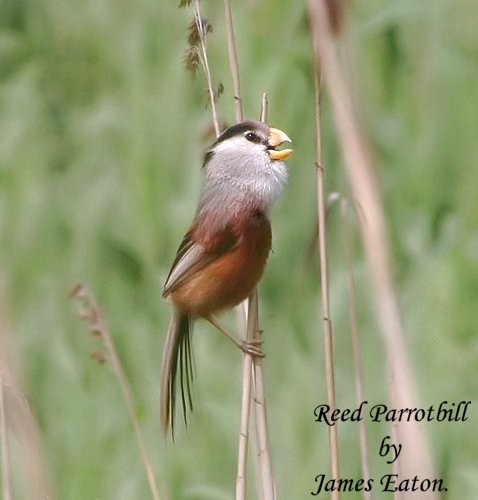Alternative names: Heude's Parrotbill; Chinese Parrotbill; Chinese Crowtit; Yangtze Parrotbill (heudei); Northern Parrotbill (polivanovi)
- Paradoxornis heudei
Identification
18 - 20cm. The only parrotbill with seasonal differences in plumage.
- Breeding:
- Crown to upper mantle plain slate grey
- Black lateral crownstripe from above eye to nape side
- Lower mantle to back dark chestnut
- Lower breast dark chestnut, lower flanks chestnut-tinged
- White eyering, whitish cheek to supercilium and throat side
- Yellow bill
- Non-breeding:
- Broadly streaked forehead and crown centre to nape with pinkish-cream and ash-grey
- Broad lateral crownstripe streaked black and rather warm brown
- Pale pinkish-cream ear-coverts
Sexes similar, juveniles are duller than adults.
Distribution
Found in China (Shandong south to Zhejiang and inland in Yangtze river system to north Jiangxi)
Locally common.
Taxonomy
This is a monotypic species,
It was formerly considered conspecific with Northern Parrotbill.
Habitat
Found in lowland reedbeds.
Behaviour
Feeds on insects.
Usually seen moving through reedbeds in groups of 5 to 15 birds, sometimes more. During breeding season in pairs.
Breeding season from May to August. The nest is a beautiful cup-shaped structure made of strips of dead reed sheats. It's placed around 1.5m above the ground, among reeds and supported by two reed stems (like the one of Eurasian Reed-Warbler). Lays 2-5 eggs.
Resient species.
References
- Clements, JF. 2008. The Clements Checklist of Birds of the World. 6th ed., with updates to December 2008. Ithaca: Cornell Univ. Press. ISBN 978-0801445019.
- Del Hoyo, J, A Elliott, and D Christie, eds. 2007. Handbook of the Birds of the World. Volume 12: Picathartes to Tits and Chickadees. Barcelona: Lynx Edicions. ISBN 978-8496553422
Recommended Citation
- BirdForum Opus contributors. (2024) Reed Parrotbill. In: BirdForum, the forum for wild birds and birding. Retrieved 15 May 2024 from https://www.birdforum.net/opus/Reed_Parrotbill




